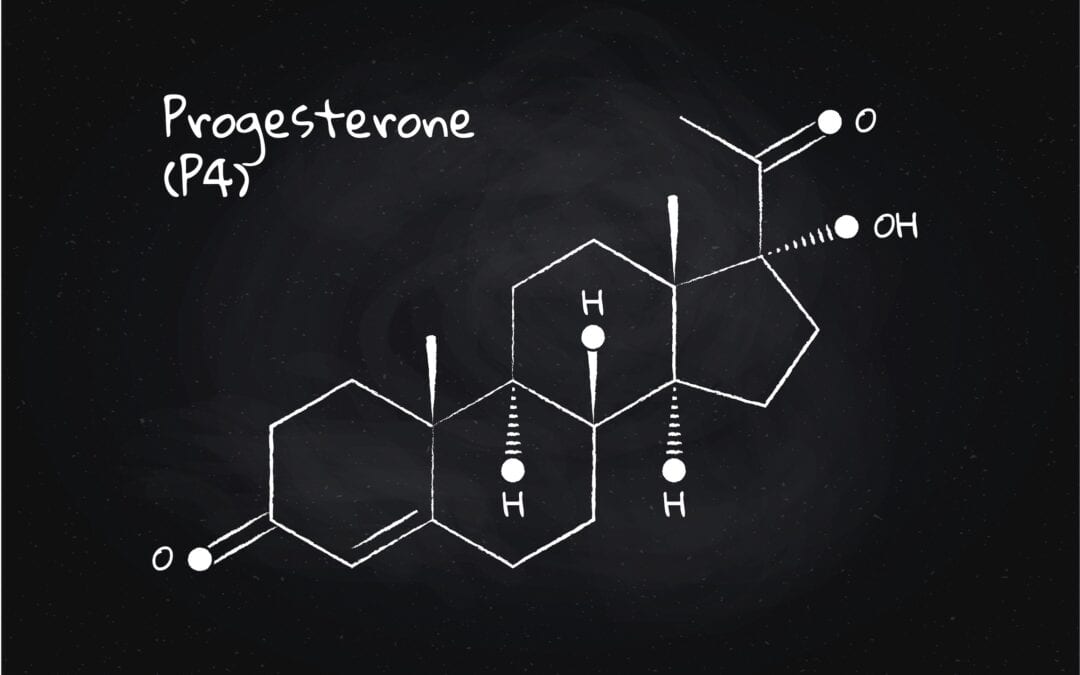Progesterone and acne
Androgens (testosterone and DHT) are usually the first suspects when looking to arrest the course of hormonal acne. However, sub-optimal levels of progesterone should also be in the frame.
What is progesterone?
Progesterone is a steroid sex hormone. As the name implies, progesterone promotes gestation – the growth and development of the fetus in the womb. Premenopausal women (not on hormonal contraception) cyclically make progesterone via ovulation. Postmenopausal women produce a small amount in the adrenal glands.
Hormonal contraception does not contain progesterone
Although hormonal birth control is often spoken about as containing “progesterone” this is not accurate. They use a synthetic version known as progestin which does not have the same effects in the body as your natural progesterone.
What else does progesterone do?
In addition to its role in reproduction, your natural progesterone also supports:
- Mood – progesterone metabolites have a calming effect in the brain. Progesterone is your natural “valium”.
- Healthy fat metabolism. Progesterone is “thermogenic” meaning it boosts your metabolism. It’s one of the reasons women can gain weight around perimenopause when progesterone naturally declines.
- Fluid balance. Progesterone is a natural diuretic.
What role does progesterone play in the skin?
Progesterone and acne
Progesterone has both direct and indirect roles in skin health.
Direct
Progesterone suppresses 5-alpha-5 reductase, the enzyme responsible for converting testosterone to dihydrotestosterone (DHT). DHT is around four times more likely to trigger acne breakouts.
Indirect
In low progesterone states oestrogen is, relatively speaking, high. (Even if you the number for estrogen looks in the normal range on a test.) This relative “oestrogen dominance” can raise insulin levels. High insulin increases both the size and amount of oil your sebaceous glands secrete.
Balanced progesterone and oestrogen support healthy skin circulation and detoxification. It also interacts with your natural collagen to improve the firmness and hydration of the skin.
Signs and symptoms of low progesterone
- Pre Menstrual Syndrome (PMS) (mood disorders, anxiety, fluid retention, sore breasts)
- Fibroids
- Recurrent miscarriages
- Heavy or very light periods
- Spotting before your period starts
- Increased pain sensitivity
- Insomnia and waking in the middle of the night
- Low libido
- Poor thyroid function
What causes low progesterone?
Low progesterone is caused by either a failure to ovulate or a poor corpus luteum function (The corpus luteum is the temporary endocrine gland created when you ovulate. It’s your progesterone-making factory). The number one reason for insufficient or lack of ovulation is stress.
Why does stress shut down ovulation?
Well, from an evolutionary perspective, it makes sense to halt reproduce if times are tough. It takes an enormous amount of physical, mental and emotional resources to sustain a pregnancy and care for an infant. Your body prioritises your survival over reproduction. Even if you’re not looking to start a family, it can be helpful to think of this in terms of creating hormone balance. Is your brain getting signals from your diet and lifestyle that you are in survival mode?
The many faces of stress
- Psychological stress: work relationships, financial, traumatic events
- Physical stress: high exercise, low body fat, poor sleep
- Diet: calorie restriction, nutrient deficiencies
- Environmental: air pollution, Xenoestrogens
Other reasons for not ovulating
- Taking hormonal contraception. This is how hormonal contraception works. It stops natural ovulation.
- Coming off hormonal contraception. It may take up to 12 months for your pituitary to start signalling your body to make hormones when you stop the OCP. Many women do establish a regular cycle before this, though.
- The eight or so year perimenopausal transition begins in your 40s. During this time, it is not unusual to have cycles where you don’t ovulate.
- Thyroid issues
- Inflammatory states such as PCOS, diabetes, heart disease or immune illnesses
- Elevated levels of the hormone prolactin.
Strategies to support ovulation and boost progesterone
- Stress management is an excellent starting point. I’m not talking stress elimination here because that’s unrealistic. Build resilience so you can dial down the stress response and recover well.
You can boost your stress resilience muscle by prioritising sleep, creating time for relaxation and fun, setting boundaries and getting the support you need for psychological or emotional trauma.
- Eat a healthy nutritious diet with plenty of fibre, adequate protein and healthy fats. Reducing processed foods and alcohol is also a good idea. Low carb diets are popular, but many women need a small number of starchy carbs like sweet potato or rice to support ovulation.
- Maintain a healthy body fat percentage. A 22-25% body fat is considered to be optimal, but this does depend on your body type. Naturally, leaner types may ovulate with 18%, and some women can have up to 30%.
- Avoid overtraining. Women who do intense training as in long-distance running, elite sports and professional dancers may not menstruate. Alternating harder sessions with easier recovery sessions may help establish a regular cycle.
- Reduce exposure to Xenoestrogens. Endocrine-disrupting chemicals found in plastics can disrupt our delicate hormone balance.
- Supplement with ovulation supporting nutrients including iodine, zinc, selenium, B vitamins, magnesium, Vitamin C if your diet is not providing adequate amounts of these. I recommend working with someone and getting tested as having too much of some of these nutrients can be detrimental.
- Herbal help with ovulation: Chaste berry (Vitex agnus-castus) is the most well known, but it may not be suitable for everyone. As with nutritional supplementation, I advise working with a Herbalist/Naturopath to get the perfect blend/dose for you.
A note on testing progesterone
When evaluating progesterone (in a naturally occurring menstrual cycle), it is essential to test it in the correct phase of your cycle.
Test in the luteal phase (second half) of your cycle. If your cycle is regular, time your test for seven days before your next expected period. This is when progesterone should be at its peak. In a 28 day cycle, you’ll test on Day 21 (Counting from Day 1 as the first day of your previous menstrual bleed.) In a 35 day cycle, you’d be testing on day 28.
If you test during the follicular phase (menstruation to ovulation), progesterone will be low. This is as it should be.
It’s all about balance
Lastly, hormones don’t work in isolation. It’s all about getting a healthy balance. So although we’ve taken a deep dive into progesterone don’t neglect the others.
Did balancing your progesterone help improve your skin? Let me know and leave any questions in the comments.
If you liked this you might also enjoy:

Need help in treating acne naturally?
Norelle Hentschel is an experienced Naturopath with a clinic in Stones Corner, South East Brisbane and also offers Telehealth consults Australia wide. She enjoys supporting her clients to reach their health goals.
Want more articles like this?
Join us at Your Skin Remedy – the monthly missive for healthy skin from the inside out. Practical, actionable, and informative. Your clear, glowing skin starts here.
PS. Your inbox real estate is precious. Your Skin Remedy is pitch and promo free. I promise. One email a month — that’s it.

